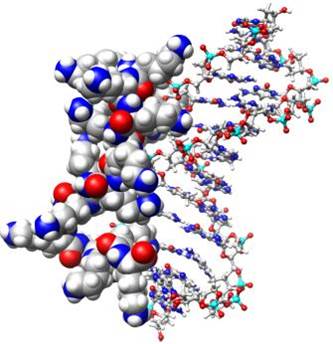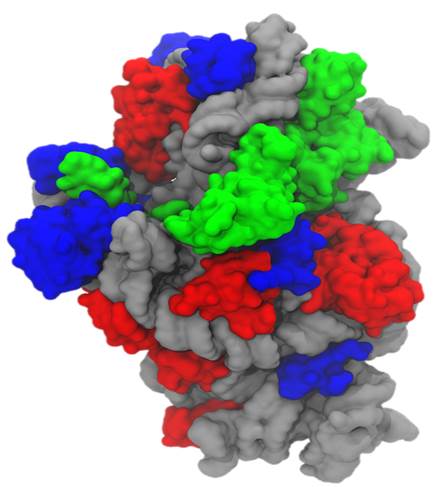Current Research
Our group is interested in deveoping and applying theoretical and computational approaches to investigate underlying molecular processes in macromolecular systems and in nanomedicine. Over the years, we became involved in several different projects. Below gives a short summary of each project on how we began and what we have achieved and what we are currently focusing on.
Plasmonic Properties of Metallic Colloidal Particles
Metallic colloidal nanoparticles such as gold or silver have very interesting plasmonic properties and have many interesting applications such as sensing or imaging. We became involved in this area of study mostly because of Dr. Xiaohua Huang who joined us here as a faculty member at Memphis. Dr. Huang worked with Prof. Mostafa El-Sayed during her Ph.D. training at Georgia Tech and she developed bioconjugated gold nanorods to kill cancer cells with photothermal therapy. Research activities in her group focuse on the use of these novel metallic nanoparticles in biomedical applications, and we are intriqued in understanding the plasmonic properties of these metallic nanoparticles. Together, we hope to establish a better structure-property relationship of these metallic colloidal nanoparticles, particuarly those anistropic core-shell structured nanoparticles.
Polymer Based Gene Gelivery
Polymer are often used as delivery vehicles in gene and drug delivery systems since  polymer chemists are capable of synthesizing and tailoring
their srucutres in many different ways. When gene therapy became possible since early 1990's, polymer was
sought after as a substitute of viral-based delivery vector since viral based delivery vector poses
unknown immune responses. The strucutral aspect of how cationic polymers complex with nucleic acids and
how these polymer cations assist in the successful gene delivery is what we aim to get a fuller
understanding. We have been working in this area since 2008. Learn more about what we have achieved so far
in this project by following the link. (coming up soon)
polymer chemists are capable of synthesizing and tailoring
their srucutres in many different ways. When gene therapy became possible since early 1990's, polymer was
sought after as a substitute of viral-based delivery vector since viral based delivery vector poses
unknown immune responses. The strucutral aspect of how cationic polymers complex with nucleic acids and
how these polymer cations assist in the successful gene delivery is what we aim to get a fuller
understanding. We have been working in this area since 2008. Learn more about what we have achieved so far
in this project by following the link. (coming up soon)
Separation and Characterization of Complex Polymers
Complex polymers refer to these polymers that possess complex chemical composition distributions and/or architectural distributions than linear homopolymers. Examples of these complex polymer systems are block copolymers, graft polymers, and ring or star polymers. The need to characterize these complex polymer systems have led to the development new separation methods for polymers. In order to gain better understanding and better control of the separation in these experiments, we perform computational/theoretical studies that examine how the interactions of complex polymers with column substrates (usually nanoporous materials) control the equilibrium distribution and transport of polymers in nanopores. We have been working on theory and simulation in this area since 2000. Follow the link to learn more about what we have achieved in this project here.
Functional Control and Assembly of Ribosome

Ribosome has been the center of research attention in molecular biology and structural biology for decades. From the initial cracking of the genetic condon table, to structural elucidation of how ribosome functions, and to the assembly process, this macromolecular system fascinated scientists immensely. We investigated the domain motion in ribosome as revealed with elastic network model in 2004 and later we became interested in the assembly of the 30S ribosome. Follow the link to to learn more about we have learned so far (coming up soon)